Bruno Peyron / Orange II
The pioneer of the Jules Verne Trophy reasserted his authority over the route via the three capes. With a boat whose every millimeter was regulated, a devoted crew and favorable weather conditions, Bruno Peyron accomplished a virtuoso voyage. It was thus that the skipper from La Baule beat the circumnavigation speed record for the third time in his career and carried off the Trophy with flying colors.
On 24 January, at 11 hours, 3 minutes and 7 seconds, local time, the maxi catamaran Orange II crossed the starting line, an invisible line stretching between Ushant and Lizard Point. 2005 marked the centenary of the death of Jules Verne. Bruno Peyron honored the memory of the father of Phileas Fogg by again rising to the challenge of going around the world in under 80 days.
This time, the stakes were twice as high. It was a matter of taking the Jules Verne Trophy back off Olivier de Kersauson, his eternal rival, but also bettering the absolute round-the-world speed record held by billionaire adventurer Steve Fossett.
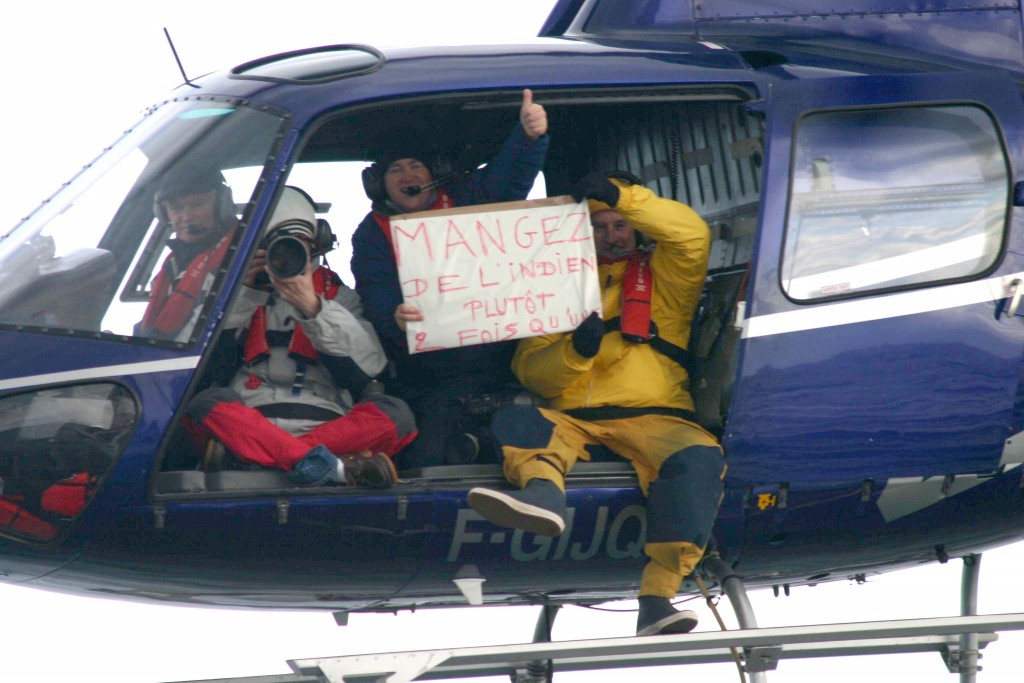 Encouragment on the starting line.“Eat indian twice rather than once” is written on the sign, refering to Geronimo and Cheyenne, the two vessels Bruno Peyron has decided to challenge. ©Photo Jean-Baptiste Epron
Encouragment on the starting line.“Eat indian twice rather than once” is written on the sign, refering to Geronimo and Cheyenne, the two vessels Bruno Peyron has decided to challenge. ©Photo Jean-Baptiste Epron
Debate
In 2002, a debate had been sparked off between the “legalist” founders of the Jules Verne Trophy, with Florence Arthaud and Titouan Lamazou in their front ranks, and the supporters of Fossett. The latter, before embarking on his attempt, had refused to pay the registration fees required by the Trophy’s regulations, as well as to agree to the ban on exterior assistance, also part of these same regulations.
Unregistered, Fossett finally pulled off a brilliant world tour, following the course stipulated by the Trophy’s rules, and without outside help, in 58 days, 9 hours and 32 minutes on board his catamaran Cheyenne. Following this victorious circumnavigation, the American skipper wanted to settle the registration fees and see his record engraved on the plaque of the mythical trophy. The Tour du Monde en 80 Jours association, as guarantor of the race’s rules, hailed his performance but refused to award the trophy to him. It was Olivier de Kersauson, who left later in the season on board the trimaran Geronimo, who inherited the title and added his name, for a second time, to the list of triumphant skippers who had earned the Jules Verne Trophy.
Bruno Peyron, as double record-holder, in 1993 then in 2002, had shown support for Steve Fossett: “I deplore the fact that this new reference time is not acknowledged in the context of the Jules Verne Trophy. It is a shame that the individualism and personal interests of each lead us to situations detrimental to the general interest.”
In his own way, almost three years later, the skipper from La Baule on the Atlantic coast prepared to restore brilliance to the challenge that he perceived as tarnished.
14 + II
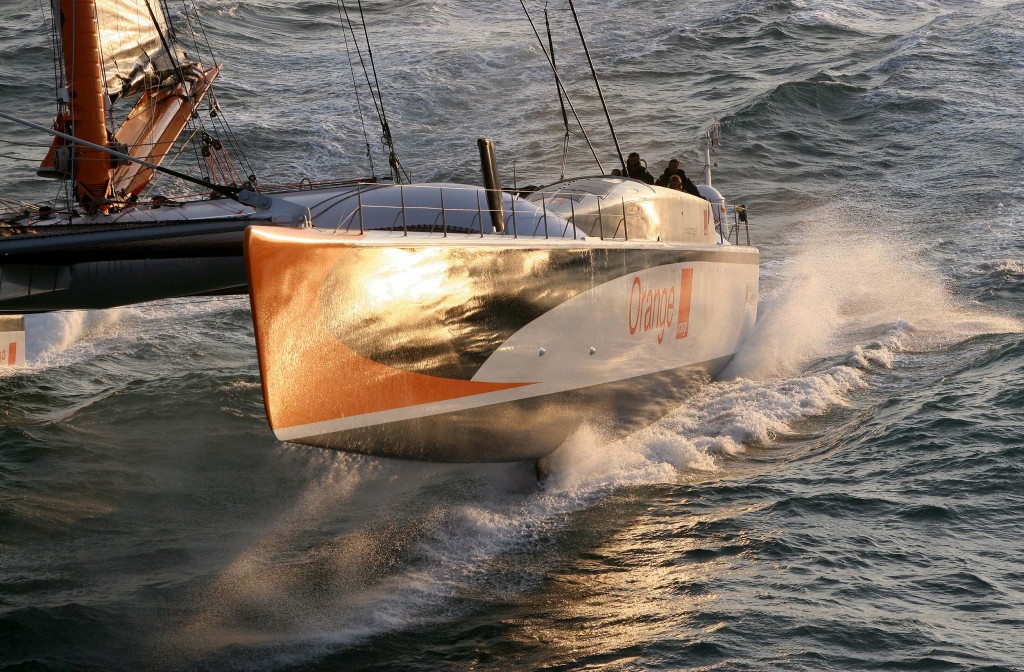 © Photo Jacques Vapillon
© Photo Jacques Vapillon
“Orange II is a priori the fastest in the world,” stated Bruno Peyron before casting off. “It showed its great potential this summer with its 24-hour record and its record for crossing the Mediterranean. It’s up to us to show that it’s the fastest to go around the world today.”
Indeed, the vessel in question was a competition machine, designed for long-distance speed: 36.80 meters long, 18 meters wide, tall streamlined hulls for cutting through waves, and a 45-meter wing mast for 1100m2 in downwind sails.
“Orange II offers a synthesis of everything we’ve learned about big racing boats in the last ten years,” summed up Gilles Ollier, one of the catamaran’s designers(1)(1)Orange II was designed by Gilles Ollier and constructed by the yacht builder Multiplast in Vannes.. “The acquired knowledge could allow us to construct the hull of a 60-meter boat, twice as long as this one, but equipment would have to match up and the crew remain the master of the machine.” The Orange II mainsail weighed 600 kilos, and the stress on the mainsail’s mainsheet was 22 tons. Bruno Peyron knew that his boat was very big, very heavy and heavily sailed. “We always need to stay utterly clear-sighted about the potential for power in our hands,” he said.
For his high-speed world tour, Peyron relied on 13 hardened crewmembers(2)(2)The Orange II crew-members: Bruno Peyron (skipper), Roger Nilson (navigator, doctor), Lionel Lemonchois (shift manager-helmsman), Philippe Péché (shift manager-helmsman), Yann Elies (shift manager-helmsman), Ronan Le Goff (N°1, in charge of deck equipment and rigging), Sébastien Audigane (helmsman, in charge of security), Jacques Caraes (trimmer, in charge of videos), Florent Chastel (N°1, in charge of running rigging), Yves Le Blévec (trimmer, in charge of general organization), Jean-Baptiste Epron (trimmer, in charge of supplies and logistics), Nicolas de Castro (N°1, in charge of composite components), Ludovic Aglaor (helmsman), et Bernard Stamm (helmsman, in charge of mechanics). – racers and Cape Horn sailors, some of whom were already familiar with the trophy course and the boat. While going under the 60-day mark remained hypothetical, the crew knew that it only had enough provisions for 58 days. “Psychologically, it’s good to tell ourselves that we have nothing to eat beyond 58 days,” commented the skipper.
Victory count
The shortest time to the equator – 6 days, 11 hours and 26 minutes from Ushant – would be the only of Olivier de Kersauson’s records to be left untouched. Once this first geographical mark on the course was crossed, Orange II’s fourteen team-members would beat the timers of Geronimo and Cheyenne.
On 5 February, on the thirteenth day of sailing, Saint Helena’s High was already far behind them. “This morning, the gates of the South, of the open sea, opened up with a cortege of huge birds,” broadcasted Jean-Baptiste Epron, the reporter on board. “The colors have turned grey, the sun is now going to turn its back on us for some time. From the tall, proud solent, we’ve moved onto the small gennaker, in other words the ‘g-string’!”
Bruno Peyron reached the longitude of the Cape of Good Hope (20° East) at 18 hours and 22 minutes (GMT) on 7 February, signing two new benchmark times: Ushant-Good Hope in 14 days, 5 hours and 21 minutes(3)(3)2 days, 6 hours and 16 minutes less than Olivier de Kersauson in 2003. and Equator-Good Hope in 7 days, 2 hours and 22 minutes(4)(4)2 days, 11 hours and 5 minutes less than Steve Fossett in 2004.. Orange II scored a four-day advance on the two previous records.
The first iceberg, an estimated fifty meters long and ten meters high, was noticed six miles from the boat on 8 February. At the helm, Bernard Stamm luffed in time to just avoid, by twenty meters, an iceberg that had strayed from growlers bobbing in the wake of icebergs. A watch from the float in the wind was added to the radar watch. Caution was taken when overtaking floating objects. And while the elements seemed to spare the catamaran from too much speed in this minefield, the wind weakened. Under the curious gaze of albatrosses, advantage was taken of the short respite to inspect the rigging that was likely to be rudely tested in the Great South being traversed by Orange II.
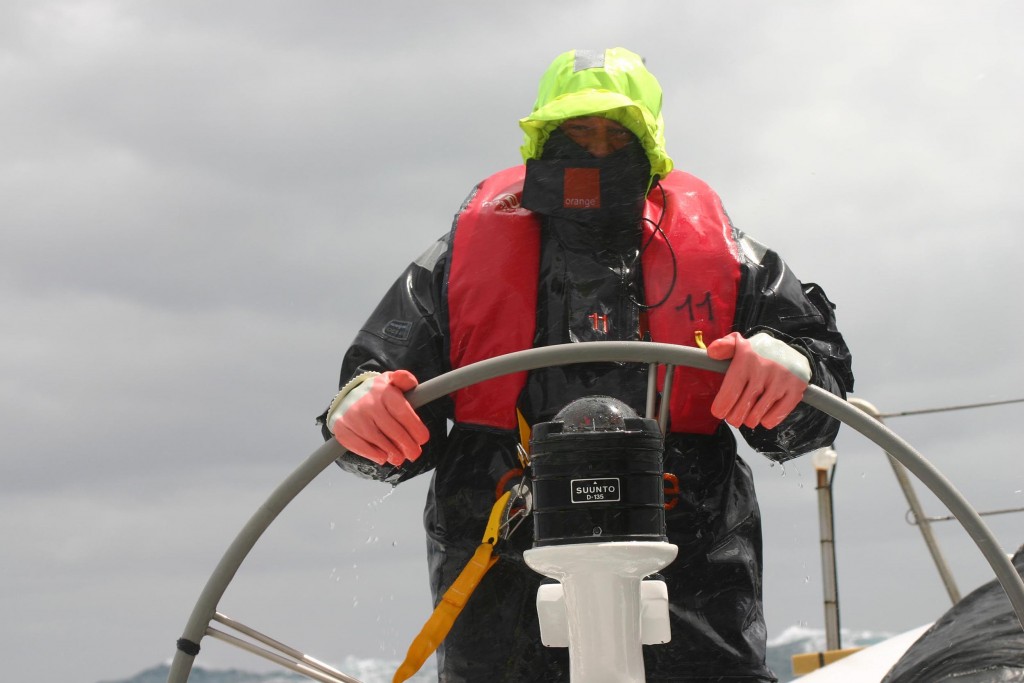
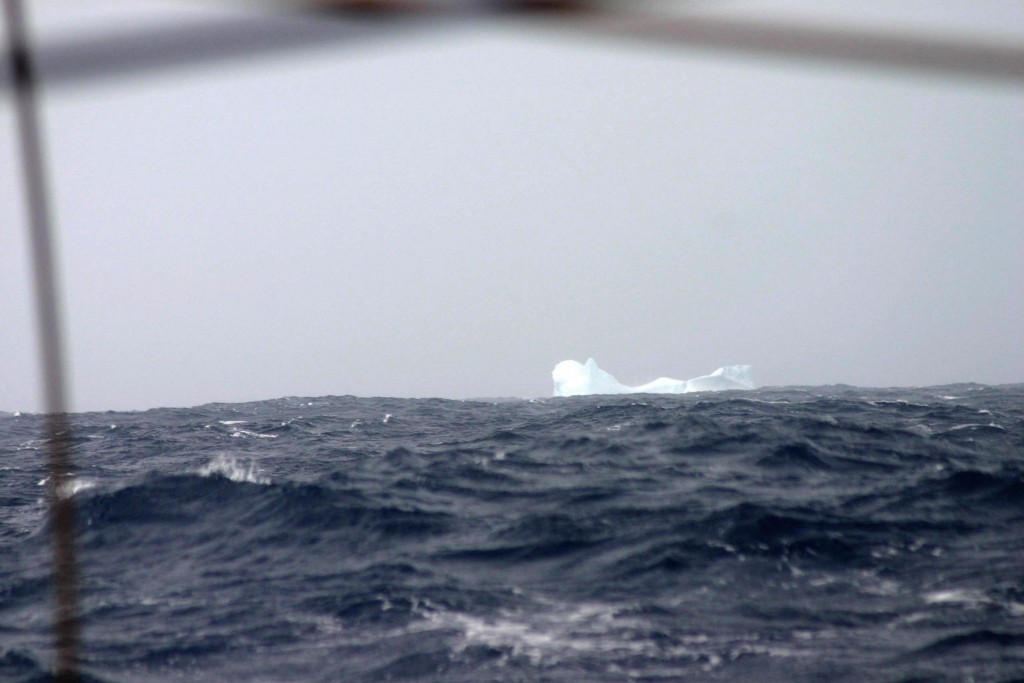 ©Photo Jean-Baptiste Epron
©Photo Jean-Baptiste Epron
Things took off again on 12 February. With a small gennaker, staysail and mainsail with one reef, Orange II sped on. The catamaran crossed the longitude of Cape Leeuwin (115°08 E) at 23 hours and 58 minutes (GMT), in other words after 21 days, 13 hours and 54 minutes by sea from Ushant, at an average of 22.8 knots. The Indian Ocean was swallowed up in 7 days, 8 hours and 33 minutes.
Bruno Peyron then had to slow down on a heavy sea with six- to eight-meter waves to allow a violent front, boding for winds at an average speed of 40 to 45 knots, to go ahead of them.
On 19 February, after 25 days, 21 hours and 33 minutes from Ushant, the skipper from La Baule and his crewmembers went over the Anti-meridian(5)(5)The 180th meridian, the opposite of the Greenwich Meridian., setting a new reference record. The four-day advance on Cheyenne’s absolute record was maintained. Orange II’s average speed from the start was 23.2 knots.
The fourteen crewmembers went around Cape Horn in the deep of the night of 26 February, at 23 hours and 32 minutes (GMT), thus smashing all intermediary times: Ushant – Cape Horn in 32 days, 13 hours and 29 minutes; Tasmania – Cape Horn in 8 days, 18 hours and 6 minutes; Cape of Good Hope – Cape Horn in 18 days, 8 hours and 8 minutes; Cape Leeuwin – Cape Horn in 10 days, 23 hours and 35 minutes.
At this point, Peyron was ahead of Fossett by 7 days, 2 hours and 47 minutes.
Punishment
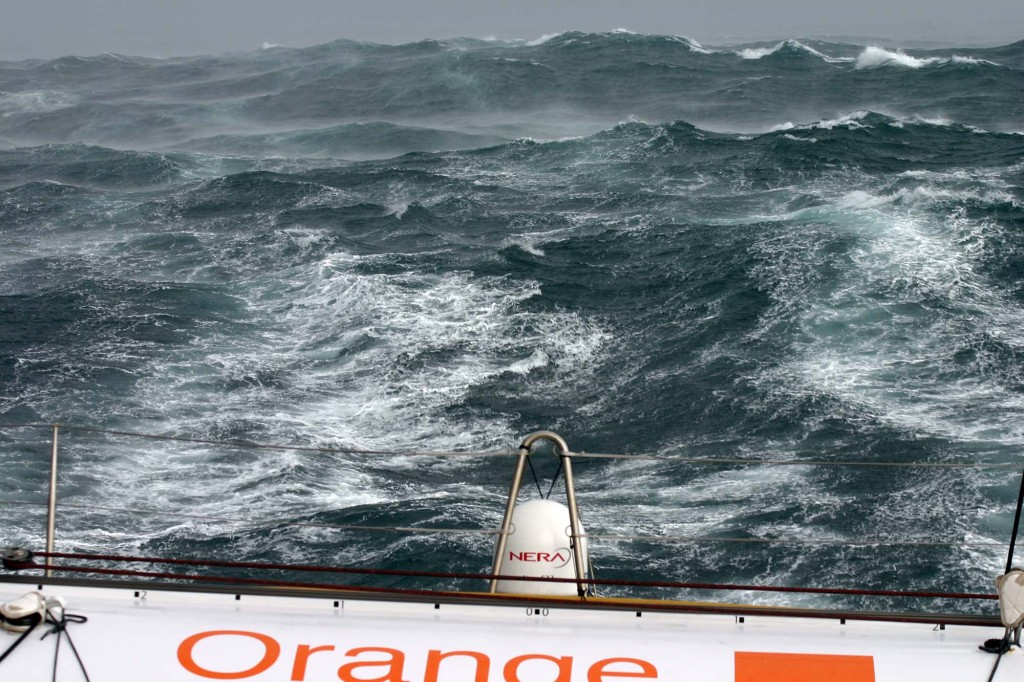 ©Photo Jean-Baptiste Epron
©Photo Jean-Baptiste Epron
“Nice welcome,” was Jean-Baptise Epron’s ironic comment about their entrance to the Atlantic. With 50-knot squalls, the crew took in reefs, rolled up the gennaker and lowered the sails. Here, Orange II met the maximum wind that it would have to face on a tour where the weather systems seemed to succeed one another with the aim of smoothly paving the maxi-catamaran’s way.
When, at 40 knots of wind, Orange II passed the pebbles of the Falklands and anchored cargo ships by several hundreds of meters, the skies cleared and the sea flattened.
On 5 March, over the radio, Bruno Peyron however showed himself to be wary: “For three days, every time I open the weather file, I prefer to close it again and try to convince myself that there’s time for everything to change and no reason to stress for nothing. But every new file is worse… So let’s be ready tomorrow to pay for yesterday’s insolence…” Orange II was stuck in a calm zone. The dead calm wore on the men’s nerves. Their cigarette stock was exhausted, and the smokers on board became irritable. “For the crew, after forty days or so at 25 knots, loitering at three knots with peaks of six is difficult to bear,” summed up Epron. To occupy the time and in anticipation of the North Atlantic, the crew made a general inspection of the hull and rigging. Two-thirds of the way through the world tour, fatigue was palpable.
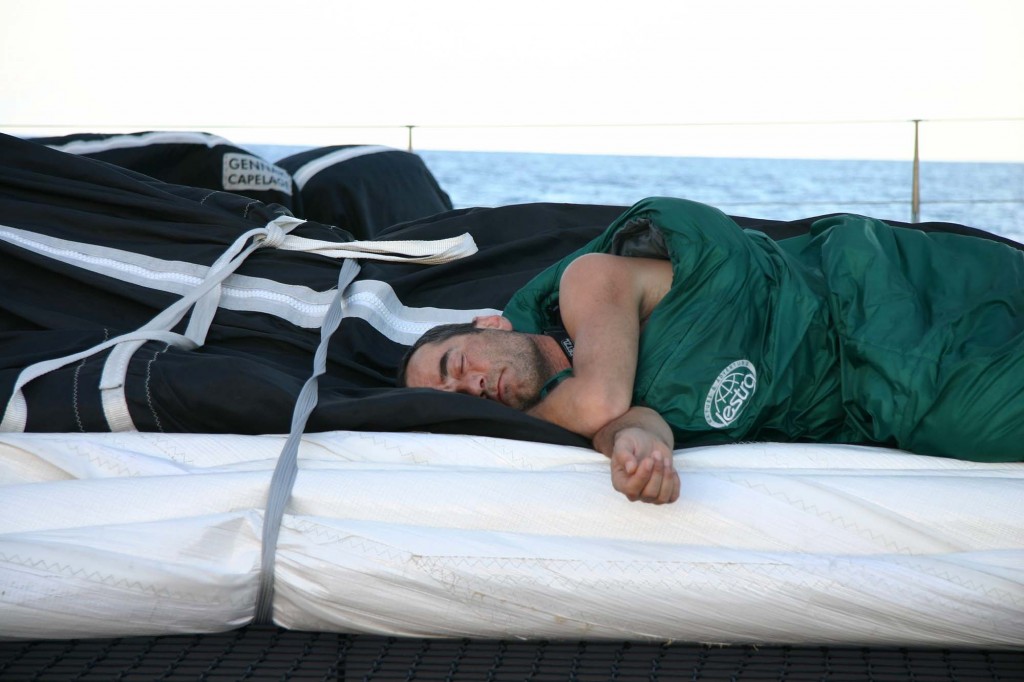
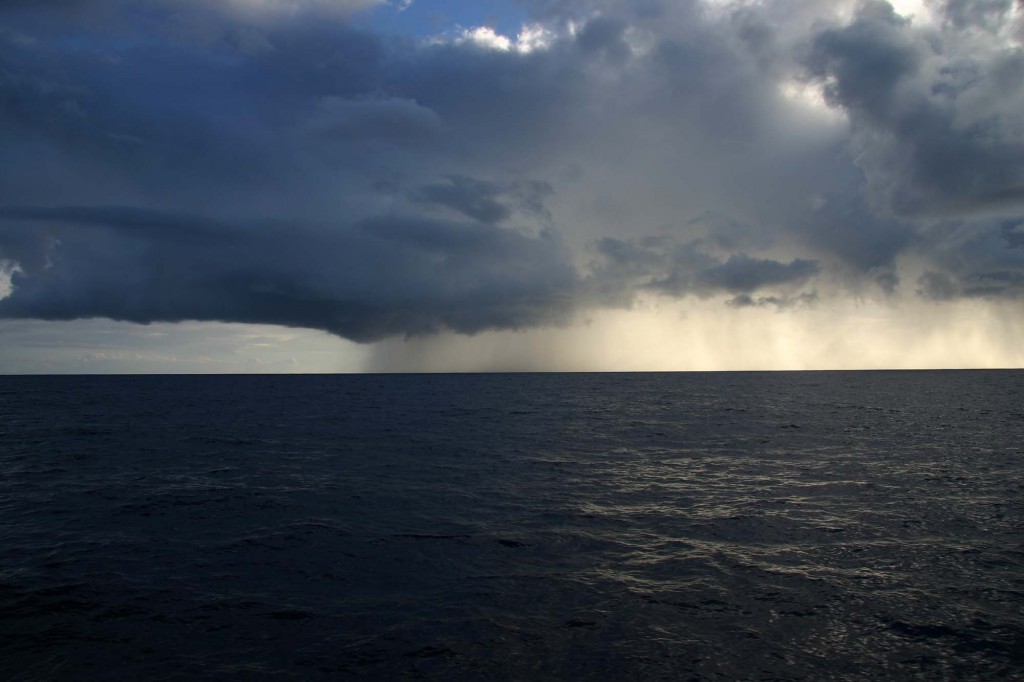 ©Photo Jean-Baptiste Epron
©Photo Jean-Baptiste Epron
On 6 March, the equator was crossed downwind. The northward passage brought a return of rain, grey skies and upwind conditions. Orange II took 40 days, 19 hours and 9 minutes from Ushant to cross the latitude 0°. Two new performances could be added to the list: Cape Horn-Equator in 8 days, 5 hours and 36 minutes and Equator-Equator, rounding the three capes (Good Hope, Leeuwin and Horn), in 33 days, 16 hours and 9 minutes. Enough to put the skipper at ease.
But Peyron, despite being 9 days and 8 hours ahead of Fossett, still feared a bad turn in the weather that would compromise his comfortable exploit. “Clearly, I feel like we need to prepare for a real punishment in this last part of the course,” he confided over the radio waves, “perhaps to pay for this almost too perfect trajectory since the start, this series of dreamlike conditions, these miles chomped up at 30 knots and these almost unreal ten days ahead three-quarters of the way through the voyage.”(6)(6)Transcripts of radio sessions, statistics and a detailed course narrative on www.fralo.info
Terminus Ushant!
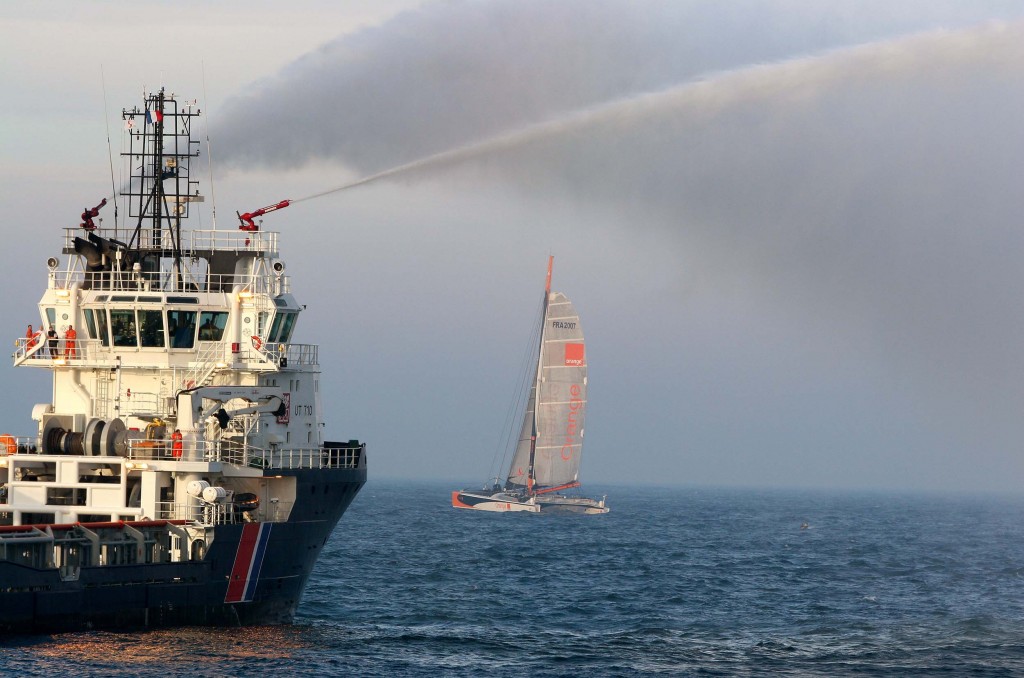 © Photo Jacques Vapillon
© Photo Jacques Vapillon
The Azores High raised a barrage that was difficult to get around, but nothing that was impossible for the maxi-catamaran. Orange II found wind again on 12 March, setting it on track for the final stop, Ushant, on the night of 15 March, after 50 days, 16 hours and 20 minutes at sea. Orange II kept up almost one week’s advance on the world record, and 12 days, 21 hours and 39 minutes on the previous holder of the Jules Verne Trophy. Fossett’s record was archived, Kersauson dethroned.
The skipper from Brittany who thus lost his title publicly saluted the performance of his rival and shared his pride: “The fifty-day mark is now close. No other mechanical sport can boast of such progress, with every generation of boats pushing back the limits further. With this Jules Verne Trophy that remains the absolute reference in terms of human and technical commitment, Bruno Peyron has just written, for the third time, a magnificent chapter.”
In 2005 as in 1993, the exploit was unexpected, and the record all the more spectacular. However, for the long-distance sailor, it wasn’t just about glory. “Those who, like us, have the privilege of travelling far and long have mixed feelings as the end approaches,” confided Bruno Peyron the day before his victory. “Of course there’s the desire to arrive, to end the story wonderfully, to be reunited with friends and loved ones. But at the same time, we become aware that we are going to separate and that the magic group that we form will be scattered…”
16h | 20min | 4s
2005
2005-01-31
10H04
00°40 N
25°84 W
21
LOADING...
2005-02-06
10H08
42°08 S
01°36 E
28
LOADING...
2005-02-09
10H00
48°08 S
40°40 E
20
LOADING...
2005-02-28
10H02
39°92 S
47°28 W
22
LOADING...
2005-03-04
10H00
14°.00 S
34°72 W
7
LOADING...
2005-03-06
10H10
1°24 N
32°32 W
21
LOADING...
2005-03-09
10H00
16°80 N
38°12 W
6
LOADING...

